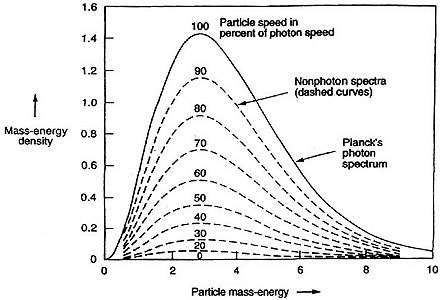The Photon-Nonphoton Universe Concept
Photons and Nonphotons in Equilibrium
The fusion-fission postulate, together with the mass-energy and momentum conservation requirements, leads to a simple universe model where photons and nonphotons exist symbiotically. That is, a pair of photons may fuse to form a nonphoton which may later fission to return the same two photons to the universe. To establish the densities of photons and nonphotons that symbiotically come to equilibrium to form a 2.73 Kelvin universe, we follow the approach used by Bose to replicate Planck's black body photon spectrum. The energy of a particle is taken to equal an integer times ε, now a tiny quantum of energy that is much smaller than the average energy of microwave background photons. The figure shows how the family of nonphoton-spectrum curves tucks under Planck's curve for the photon spectrum.

Click to view a larger version of this figure
The average energies of the two particle-species in the 2.73 Kelvin universe are comparable, being of the order of a thousandth of an electron volt. The average nonphoton speed is found to be about 81% of photon speed. However, the total densities of the two species differ by a very large factor—one of the order of the ratio of the average microwave photon energy to that of the tiny ε-quantum. On the basis of the nonphoton gravity concept later discussed, we estimate that ratio to be about 1077.
The estimated “dark energy” density of the ethereal nonphotons is about 1074 times that of the observed average energy density of ponderable matter and radiation in the universe. This large dark energy density ratio falls in the wide (1055 to 10120) range compatible with quantum-mechanic considerations of the vacuum's energy. It may also be noted that a divergent chain reaction, where photons induce fission of nonphotons into photon pairs, offers an explanation of mini-big-bangs in portions of the infinite modeled universe. The matter and radiation in a 10-billion light-year radius sphere, for example, has an estimated inertial mass-energy equal to that of the photons born from the fission of all the nonphotons in a 32-meter radius sphere.
Continue reading >> Cosmological Photon Redshift